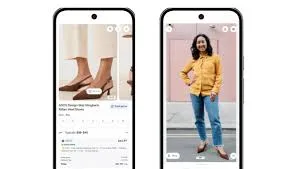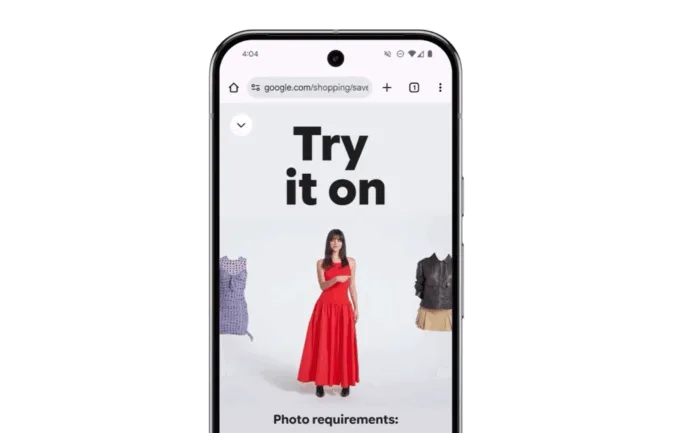Table of Contents
At Squaredtech, we track major shifts in artificial intelligence and online shopping. Today, Google has taken a bold step forward. Its Google Virtual Try On shopping tool now supports shoes. At the same time, the tool is expanding to additional countries. In this detailed article, we explain how the updated Google Virtual Try On works, its global expansion, and what this means for shoppers and retailers.
This global reach ensures that users across different countries can benefit from the innovative features of the tool.
What Is New in Google Virtual Try On: Shoe Support and Global Growth
Google’s blog states that its try on tool is now adding shoes and will expand to Australia, Canada, and Japan in the coming weeks. The move makes sense. After testing the tool for clothing, footwear is the next frontier. The updated tool now lets users see how different pairs of shoes such as sneakers, heels, boots, or sandals might look when worn by them.
How the Shoe Try On Works
The system relies on generative artificial intelligence and image modeling that perceives shapes, lighting, depth, and texture. Google claims that its try on tool accurately perceives shapes and depth, preserving those subtleties when showing how an item would look on the user.
To use it, a shopper follows these steps:
- Browse footwear listings on Google.
- Tap the “Try It On” button on a product listing if available.
- Upload a full length photo of yourself in a clear and well lit setting.
- Wait for the artificial intelligence system to generate a result. Within seconds, the shoe from that listing appears overlaid on your image.
- Save or share the generated image if you wish.
Google clarifies that users do not need to supply a photo of just their feet. The system infers and draws the appropriate foot geometry on its own.
Why Footwear Matters
Footwear has always been a difficult category for online shopping. Fit, proportion, and style perception all play major roles in the decision process. By enabling shoe try on, Google reduces hesitation and lowers the risk of returns. It helps shoppers answer questions like “Do these heels suit my posture?” or “Do these sneakers look right on me?”
At the same time, Google is expanding the clothing portion of Google Virtual Try On to new countries. Australia, Canada, and Japan are part of this rollout. This expansion shows Google’s aim to bring its artificial intelligence powered shopping experience to more global users.

As Google enhances its tool, the global shopping experience becomes increasingly interactive.
This global initiative is set to transform how users shop for footwear.
Background: From Clothes to Shoes and the Role of Doppl
To understand the current expansion, we must revisit Google’s earlier developments in virtual try on and related tools.
The Clothing Try On Launch
Google first began experimenting with virtual try on by displaying garments on a range of models. Later, it introduced the option for users to upload their own photos. That full body photo approach was first made available in the United States in mid 2025.
This earlier system used an image generation model that simulates how fabrics fold, stretch, and drape on individual body shapes. Google integrated this model with its Shopping Graph to produce realistic garment previews.
The clothing try on feature received positive engagement. Google reported that users shared their try on images more often than standard product listings.
Doppl: A Deeper Virtual Style Experience
In June, Google launched an experimental app called Doppl. This app expands what virtual try on can do by helping users explore style choices even further. Doppl can create artificial intelligence generated videos that show how outfits might look in motion.
Read More About Our Article of Google Doppl App Uses AI to Let You Try On Clothes Without Changing Published on June 27th, 2025 SquaredTech
Doppl also contributes to the global presence of Google in the fashion technology sector.
This feature enhances the global appeal of Google’s shopping tools.
Google’s virtual shopping ecosystem reflects its ambition to serve a global audience.
Although both Doppl and Google Virtual Try On rely on generative artificial intelligence, they have slightly different purposes. Google Virtual Try On focuses on shopping, while Doppl focuses on creativity and self expression. Doppl allows users to experiment with outfit combinations, explore new looks, and preview styles before purchase.
This global rollout highlights the importance of technology in modern shopping.
In simple terms, Google’s approach involves two complementary tools. One is the shopping focused Google Virtual Try On, which now includes shoes. The other is the creative fashion app Doppl. Together, they build a connected ecosystem for virtual shopping and style visualization.
What This Expansion Means for Shoppers and Retailers
We analyze how new technology changes human behavior. Here is what this expansion means for both shoppers and retailers.
For Shoppers
- More confidence. Shoppers can now preview what footwear looks like on their own body before purchasing. This reduces hesitation and uncertainty.
- Simpler decision making. Instead of guessing the size, color, or appearance, shoppers can view how the product actually looks on them.
- Social sharing. Users can save and share their virtual try on images with friends to get opinions. This increases engagement and social proof.
- Wider availability. As the feature rolls out to Australia, Canada, and Japan, more users can access it beyond the United States.
For Retailers and Brands
- Improved conversions. When shoppers see realistic previews, they are more likely to complete their purchases.
- Fewer returns. Visual confirmation helps reduce the number of returns due to mismatched expectations.
- New opportunities for integration. Brands can prepare detailed three dimensional shoe models and product assets to work with Google’s system.
- Rising competition. Other platforms such as Amazon and Walmart may soon need to offer similar virtual try on capabilities to keep up.
Industry reports show that around fourteen percent of consumers want mixed reality try on experiences in their shopping routine. Amazon and Walmart have already introduced early versions of similar technology, indicating a broader shift toward virtual product visualization.
Challenges and Limitations to Consider
The technology is impressive, but it still has limitations. As an editor at Squaredtech, here are the main issues we see.
Retailers must adapt to this global shift in consumer behavior.
- Photo quality. Poor lighting or unclear backgrounds can affect accuracy. Clear and balanced photos deliver better results.
- Depth perception. Mapping a three dimensional shoe onto a two dimensional photo can sometimes lead to slight distortions.
- Color and texture rendering. Some fabrics or materials may appear slightly different from real life.
- Limited regional rollout. The expansion beyond the United States is still limited, and Google has not released a global schedule.
- Privacy and data use. Users may worry about how their uploaded images are stored or processed. Transparency about privacy policies is essential.
As technology evolves, Google aims to lead the global market in virtual shopping.
We believe that Google should emphasize opt in consent, explain its data handling process clearly, and make it easy for users to delete their photos after use.
How to Use the Feature and Get the Best Results
If you are in the United States or in one of the newly added regions such as Australia, Canada, or Japan, here is how to get the best experience with Google Virtual Try On.
- Open Google Shopping and look for a shoe listing that includes the “Try It On” button.
- Prepare a well lit full length photo with a neutral background.
- Wear fitted clothing so the system can read your body outline accurately.
- Upload the image and let the artificial intelligence system generate your preview.
- Save or share the result with others.
- Compare several styles side by side before finalizing your purchase.
Our website recommends starting with simple items such as sneakers before testing complex designs like boots or heels. This helps you see how the system handles different textures and shapes.
Conclusion
Google’s decision to add shoe support to Google Virtual Try On marks an important expansion in artificial intelligence powered shopping. By combining realistic photo based rendering with actual product listings, Google is moving closer to a shopping experience that feels personal and interactive.
Users are increasingly seeking global solutions for their shopping needs.
Google’s tools are designed to cater to a global audience, ensuring a seamless experience.
This global initiative redefines how we perceive online shopping.
Along with its geographic expansion to Australia, Canada, and Japan, Google is extending this technology beyond early adopters in the United States.
We view this as a defining moment for online retail. Shoppers now have more control and confidence in their purchases. Retailers must adapt by preparing high quality digital assets and engaging with these new tools.
Google still needs to improve image quality, realism, and transparency, but the direction is clear. Online shopping is becoming more visual, more data driven, and more personal.
Squaredtech will continue monitoring how Google Virtual Try On develops and how users respond in different regions. Expect ongoing insights from our website as artificial intelligence transforms the online shopping experience across categories.
Stay Updated: Mobile – Artificial Intelligence


